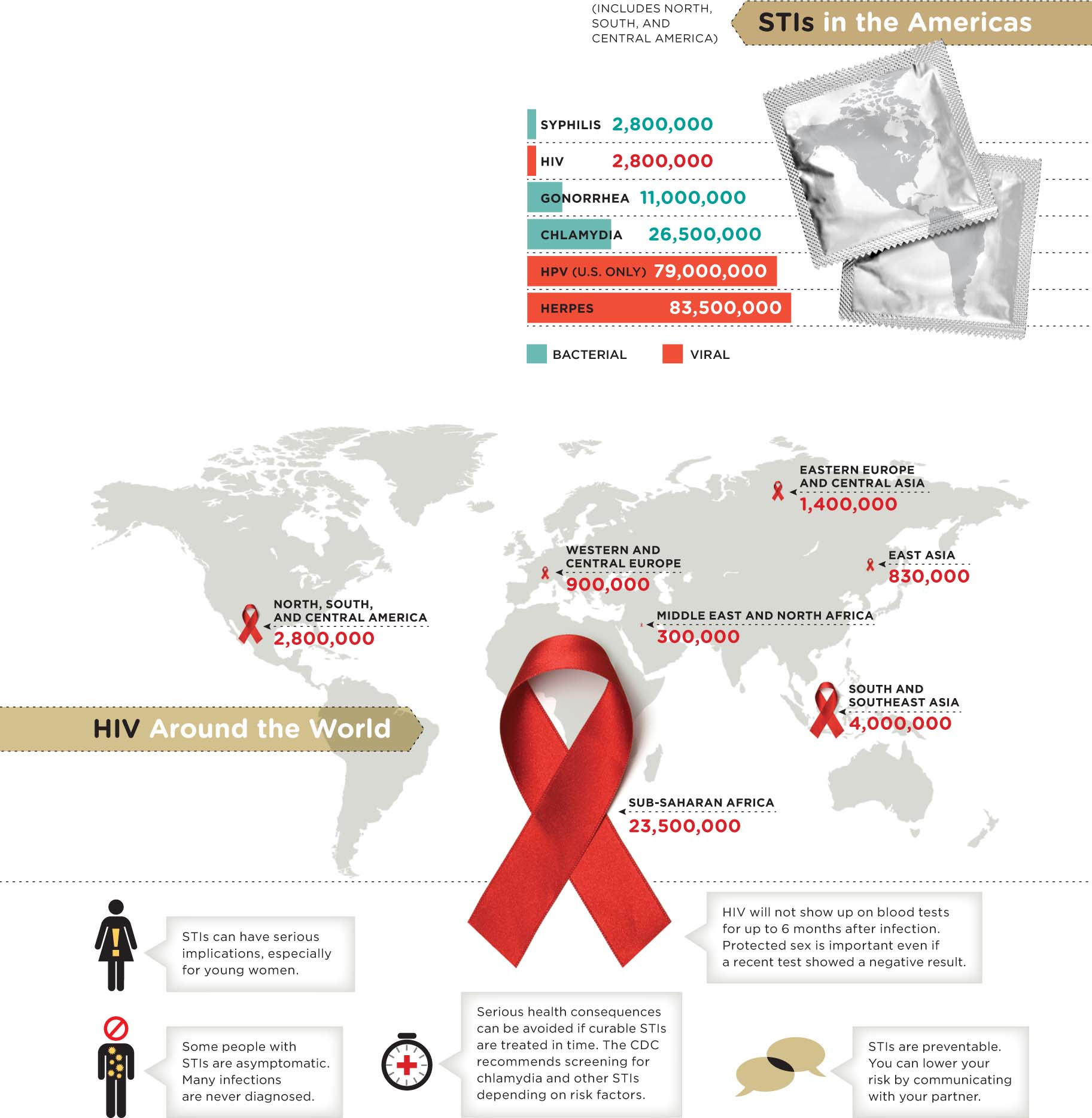10.5 Sex, Its Consequences, and Culture
Sexually Transmitted Infections
LO 9 Classify sexually transmitted infections and identify their causes
Although sex is pleasurable and exciting for most, it is not without risks. Many people carry sexually transmitted infections (STIs)—diseases or illnesses passed on through sexual activity (Centers for Disease Control and Prevention [CDC], 2012f). The more sexual partners you have, the greater your risk of acquiring an STI. But you can lower your risk by communicating with your partner. People who know that their partners have had (or are having) sex with others face a lower risk of acquiring an STI than those who do not know. Why is this so? If you are aware of your partner’s activities, you may be more likely to take preventative measures, such as using condoms. Of course, there is always the possibility that your sexual partner (or you) has a disease but doesn’t know it. Some people with STIs are asymptomatic, meaning they have no symptoms. There are many causes of STIs, but we will focus on two of the most common types: bacterial and viral (TABLE 10.5 for data on their prevalence).
| STI | Symptoms | Estimated Annual Prevalence of New Infections in the U.S. |
| Chlamydia | Women often have no symptoms; men can experience discharge from penis, burning when urinating, and pain/swelling of the testicles. | 2.86 million |
| Gonorrhea | No symptoms may be present in men or women. Men can experience burning when urinating; white, yellow, or green discharge. Women can experience pain/burning when urinating, or vaginal discharge. | 820,000 |
| Herpes | Blisters on the genitals, rectum or mouth; painful sores after blisters break; fever, body aches, and swollen glands can occur. | 776,000 |
| Human papillomavirus (HPV) | Genital warts; certain cancers; warts growing in the throat. | 14.1 million |
| Syphilis | Firm, round sores that first appear where the infection enters the body and can then spread to other parts of the body. | 55,400 |
| Sexually transmitted infections (STIs) are extremely common. HPV, for example, is so widespread that nearly all sexually active people are infected at one time or another. | ||
| SOURCES: CDC (2012 A, B, C, D, F, 2013). | ||
455
Bacterial Infections
Syphilis is a bacterial infection. Initial signs of syphilis might include sores on the genitals, breasts, anus, lips, or in the mouth. If the infection proceeds untreated over the course of years, it can lead to heart failure, blindness, liver damage, severe mental disturbance, or death. Another bacterial infection is gonorrhea, one of the most pervasive STIs in the United States. The initial symptoms of gonorrhea are more prominent for men than women. For a man, the first sign might be painful urination and cloudy discharge with a bad odor. Early symptoms in women, such as unusual discharge from the vagina, might go unnoticed or be mistaken for a less serious problem. Without treatment, men can become sterile and develop problems with the prostate and testes. Untreated gonorrhea can also lead to sterility in women. Like other bacterial infections, gonorrhea is treated with antibiotics, but resistance to these medications is becoming a problem (CDC, 2012d).
Another common bacterial infection is chlamydia. Teenage girls and young women are the most susceptible to this infection due to the immature development of the cervix. There are two types of chlamydial infections that affect women. One type affects the urethral tube or cervix; the other leads to pelvic inflammatory disease, which can result in lower back pain, menstrual difficulties, and headaches. Around 80–90% of women with chlamydia are asymptomatic, and 80% of women with gonorrhea are asymptomatic (CDC, 2012e).
Viral Infections
One of the most common viral STIs is genital herpes, caused by herpes simplex virus two (HSV-2). HSV-2 results in sores and lesions on or near the genitals. Herpes can also infect other parts of the body, such as the mouth (American Social Health Association, 2012).
Even more common than herpes is the human papillomavirus (HPV), which can cause genital warts. Over 100 types of HPV have been identified, and research shows that untreated HPV can lead to the development of cervical, vaginal, urethral, penile, and anal cancers. One of the most worrisome aspects of HPV is that many carriers have no symptoms, so they can spread the infection without even knowing they have it. Although bacterial infections often clear up with antibiotics, viral infections like herpes and HPV have no cure, only treatments to reduce symptoms.
456
HIV and AIDS
LO 10 Describe human immunodeficiency virus (HIV) and its role in acquired immune deficiency syndrome (AIDS).
Perhaps the most feared STI is human immunodeficiency virus (HIV). This virus is spread through the transfer of bodily fluids (such as blood, semen, vaginal fluid, or breast milk) and eventually causes the breakdown of the immune system. HIV often will not show up on blood tests for up to 6 months after infection, which means that even if you have had a negative test result for HIV, you cannot assume you are “safe”—hence, the importance of having protected sex. HIV eventually progresses to acquired immune deficiency syndrome (AIDS), which generally results in a severely compromised immune system. A weakened immune system makes the body much more susceptible to opportunistic infections caused by bacteria, viruses, or fungi, and this vulnerability increases as the disease progresses.
The World Health Organization (WHO) reported in 2009 that approximately 60 million people were infected with HIV and some 25 million had died of HIV complications since it was first identified in 1981. In sub-Saharan Africa, HIV/AIDS has left over 14 million children orphaned. In addition, the WHO (2009) reported that approximately 2 million people died AIDS-related deaths in 2008. In the United States, approximately 1.2 million people have HIV, and it’s likely that around 20% of these people are unaware they have the infection (Hoppel, 2012). Worldwide, HIV is a leading cause of death, and in sub-Saharan Africa it is the leading killer (Kendall, 2012). Infographic 10.2 provides a closer examination of regional statistics.

Apparently, knowing the dangers of HIV does not motivate most people to change their risky habits. Unprotected sex and intravenous (through a needle) drug use are the most common forms of transmission. There is no cure for HIV/AIDS, but anti-HIV drugs have been developed to help reduce viral levels in the blood. These medications are very expensive, with a cost of approximately $20,000 per year per person, and funding shortfalls will result in over 2,000 people in the United States not being able to get the treatments they need (Maxmen, 2012). The problem is global. In 2010, 7.6 million HIV sufferers around the world could not gain access to treatment (Granich et al., 2012).
Many people are uncomfortable discussing HIV and other STIs, and often there is a stigma attached to those who suffer from these conditions. But everyone—with the exception of those who practice abstinence—is vulnerable. When it comes to STIs, or any aspect of human sexuality, be careful about passing judgment.
“Normal” Is Relative
LO 11 Define sexual scripts and describe some of the ways people deviate from sex-related cultural norms.
It is only natural for us to wonder if what we are doing between the sheets (or elsewhere) is normal or healthy. Is it normal to masturbate? Is it normal to fantasize about sex with strangers? The answers to these types of questions depend somewhat on cultural context. Most of us unknowingly learn sexual scripts, or cultural rules that tell us what types of activities are “appropriate” and don’t interfere with healthy sexual intimacy. In some cultures, the sexual script suggests that women should have minimal, if any, sexual experience before marriage, but men are expected to explore their sexuality, or “sow their wild oats.”
457
INFOGRAPHIC 10.2: STIs Around the World
Should you be concerned about sexually transmitted infections (STIs)? Every year in the U.S., new STI cases number 20 million. Half of these new infections occur among people aged 15 to 24 (CDC, 2013). The graph at right shows estimated numbers of people living with selected STIs in the Americas. The bacterial STIs shown here in teal are curable, but can have serious health consequences if left untreated. Viral STIs, shown in red, have no cures. The map below provides estimated numbers for HIV worldwide.
SOURCES: CDC (2013); LOOKER, GARNETT, AND SCHMID (2008); UNAIDS (2012b); WHO (2008c).

458
Fetishes and Paraphilia
There are some behaviors that most people would consider unusual, regardless of culture. An example would be fetishism, a sexual fixation with an object or nongenital body part (APA, 2013). Fetishes center on just about any object you can imagine, such as stuffed animals and nongenital body parts, like bald heads or red toenails. Typically, sexual fetishes don’t present a problem unless they interfere with relationships.
How do sex therapists deal with these sexual obsessions? According to Dr. Buehler, therapists and clients in past decades would spend years trying to understand and eliminate fetishes. “These days the thinking is, if it doesn’t hurt anybody, who cares,” she says. “You like shoes? Okay. You like latex? Great. Whatever it is, it’s fine, as long as whatever activity you’re involved [in] is consensual.” The issue is usually a couple’s issue, Dr. Buehler adds. Can the partner accept the fetish, and if so, is there a way to integrate it into the couple’s sex life? If not, perhaps the partner can tolerate the other person masturbating with the fetish object.
As already mentioned, many people are not comfortable discussing their own sexual activities, which often leaves them wondering if what they do is appropriate. Sexual behavior is as varied as any other type of human behavior. As with any definition of appropriate versus inappropriate, deviant versus normal, we must always consider the sociocultural context and whether the behavior is harmful to oneself or others.
What we want to emphasize is that there is a range of sexual behavior, and the overwhelming majority of it is perfectly healthy. But some fetishes and other sexual behaviors are rare and/or problematic. Paraphilia is the term used to describe these uncommon sexual acts (TABLE 10.6). Here, the sexual activity might involve nonhuman objects, and sometimes results in the suffering or humiliation of those involved. Often, the behavior is repeated and compulsive (Kafka, 2009).
| Type of Paraphilia | Description |
| Exhibitionism | Sexual arousal as a result of exposing oneself to an unwilling bystander |
| Fetishism | Sexual arousal with an object or nongenital body part |
| Frotteurism | Sexual arousal as a result of touching or rubbing against an unwilling person |
| Klismaphilia | Sexual arousal associated with receiving enemas |
| Pedophilia | Sexual arousal associated with sexual fantasies or urges about prepubescent children |
| Sexual masochism | Sexual arousal as a result of experiencing pain or suffering |
| Sexual sadism | Sexual arousal as a result of inflicting pain or suffering |
| Telephone scatologia | Sexual arousal as a result of making obscene phone calls to an unwilling person |
| Voyeurism | Sexual arousal as a result of watching unsuspecting individuals undress or engage in sexual activity |
| Paraphilia refers to unusual sexual interests. A paraphilia becomes problematic when it causes pain or suffering in oneself or others. | |
| SOURCE: CROOKS AND BAUR (2014); MCANULTY, DILLON, & ADAMS, 2002. | |
459
Pedophilia is a paraphilia in which a person at least 16 years old has sexual fantasies or urges about children (usually younger than 14). In some cases, the person never acts on the urges or fantasies. Others, however, victimize children and develop techniques to gain access to them. Pedophilia is more common in men and appears to last throughout life (APA, 2013).
Culture and Sex

Culture plays a role in determining what sexual behaviors are deemed acceptable, and there is considerable variation in this regard. Whereas some cultures abhor nudity and view sex only as a means of reproduction, others believe that children should be educated about sex early in life. It was reported for many years that Inis Beag (a pseudonym for an island off the coast of Ireland) was a “sex-negative” society, known for abstinence, monogamy, and infrequent sexual encounters. In contrast, the “sex-positive” culture of Mangaia in the South Pacific was known for frequent sexual encounters and reports of multiple orgasms each night (Levine & Troiden, 1988).
What about Americans? Do you think we tend to promote sexual modesty? Or is the cast of the show Jersey Shore more representative? Americans generally value sexual modesty, but we are also exposed to a broad spectrum of sexual expression via the media (although there is a great deal of variation based on subcultural and regional differences within the United States). In one study from 1998, researchers examined attitudes regarding nonmarital sex in 24 different countries. They reported that the United States belonged to a cluster of countries referred to as “sexual conservatives,” with the great majority of people disapproving of any form of nonmarital sex—both premarital and extramarital (Widmer, Treas, & Newcomb, 1998). Do you think this attitude still prevails?
People engage in sexual activity for procreation, recreation, and everything in between. Sexual motives and preferences vary from person to person and across time, but are also based on culture. What motivates individuals to engage in sexual activity? Women seem more likely to be looking for love and commitment, intimacy, or to solidify a relationship. Men report being motivated by the physical appearance of their partner, pleasure, and the desire to reduce stress. While such gender disparities do exist, research reveals they are quite small (Hatfield, Luckhurst, & Rapson, 2010).
The influence of culture extends beyond sex, impacting our choices of mates and long-term sexual partners. In Chapter 15, we discuss the various factors important for interpersonal attraction, including proximity, similarity, and physical attractiveness. These variables are shaped by culture, but they may also be dependent on biology. According to one controversial theory, mate choices are guided by the forces of evolution.
CONTROVERSIES
Are You My Natural Selection?
 Sex serves an important function in human evolution; without it, none of us would be here. If you hope to pass along your precious genes to future generations, then you’d better produce vigorous children who will survive and reproduce. But you can’t accomplish this alone; you need a partner with characteristics that complement your own. How do you find this perfect someone?
Sex serves an important function in human evolution; without it, none of us would be here. If you hope to pass along your precious genes to future generations, then you’d better produce vigorous children who will survive and reproduce. But you can’t accomplish this alone; you need a partner with characteristics that complement your own. How do you find this perfect someone?

Let’s approach this question from a purely evolutionary standpoint, ignoring social and cultural factors. Men and women have the same goal—to ensure that their genes outlast them—but they have different roles in reproduction. Women generally invest more in childbearing and rearing (getting pregnant, breastfeeding, and so on) and they are limited in the number of offspring they can produce. Men are capable of fathering hundreds, if not thousands, of children, and they are not hampered by the biological constraints of pregnancy and breastfeeding. Under these circumstances, a woman’s best strategy is to find a mate who will ensure that her children have all the resources they need to survive and reproduce. A man, on the other hand, should be on the lookout for a woman who can bear many children—someone who shows signs of fertility, like youth and beauty (Geary, Vigil, & Byrd-Craven, 2004).
460
Do people really choose partners according to these criteria? One study of over 10,000 participants from 37 cultures concluded that women around the world do indeed favor mates who appear to be good providers, whereas men place greater value on good looks and youth (Buss, 1989). Subsequent studies have produced similar results (Buss, Shackelford, Kirkpatrick, & Larsen, 2001; Schwarz & Hassebrauck, 2012; Shackelford, Schmitt, & Buss, 2005).
A WOMAN’S FINANCIAL SECURITY HAS BECOME AN INCREASINGLY IMPORTANT CRITERION FOR MALE SUITORS.
Sure, we all have preferences for the type of partner we want, but do they really impact the choices we make? Do men, for instance, typically marry women who are younger? Yes, this appears to be the case. Husbands across the world are, on average, a few years older than their wives (Buss, 1989; Lakdawalla & Schoeni, 2003; Otta, da Silva Queiroz, de Sousa Campos, da Silva, & Silveira, 1999).
But let’s put these findings in perspective. Two or three years is not much of a gap if you’re thinking about growing old together. (Is age 83 really any different from 80?) And we all know there are many women in search of “hot men,” and men in pursuit of “sugar mamas.” Over the past several decades, in fact, a woman’s financial security has become an increasingly important criterion for male suitors (Buss et al., 2001). In today’s ever-changing social and cultural environment, evolution is just one factor influencing our selection of a mate.
BACK TO THE FUTURE
 You may be wondering what the future holds for Stephen Patten and Dr. Stephanie Buehler. Stephen is considering retirement in about 4 years, after which he and his wife (also a nurse) might island hop in the Caribbean or Pacific Ocean. Currently a part-time nursing instructor at a community college, he hopes to teach at local colleges in between his travels.
You may be wondering what the future holds for Stephen Patten and Dr. Stephanie Buehler. Stephen is considering retirement in about 4 years, after which he and his wife (also a nurse) might island hop in the Caribbean or Pacific Ocean. Currently a part-time nursing instructor at a community college, he hopes to teach at local colleges in between his travels.
 Dr. Buehler is currently writing her second book, a text intended to help general therapists address sexual issues with clients (in other words, what every therapist needs to know about sex). In between speaking engagements, she also plans to organize continuing education activities for therapists who want to learn more about sex therapy.
Dr. Buehler is currently writing her second book, a text intended to help general therapists address sexual issues with clients (in other words, what every therapist needs to know about sex). In between speaking engagements, she also plans to organize continuing education activities for therapists who want to learn more about sex therapy.
461
show what you know
Question 10.16
1. __________ and __________ are both bacterial infections that are spread through unprotected sexual activity.
- Syphilis; gonorrhea
- Pelvic inflammatory disease; herpes
- Human papillomavirus; herpes
- Syphilis; acquired immune deficiency syndrome
Question 10.17
2. Most people learn __________, which are the rules our culture has taught us about what is “appropriate” for sexual activity.
Question 10.18
3. Describe how HIV is transmitted and how it progresses to AIDS.
 CHECK YOUR ANSWERS IN APPENDIX C.
CHECK YOUR ANSWERS IN APPENDIX C.